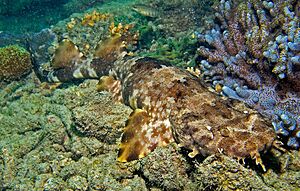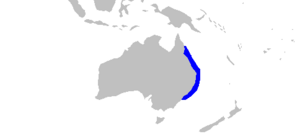Ornate wobbegong facts for kids
Quick facts for kids Ornate wobbegong |
|
|---|---|
 |
|
| Ornate wobbegong in the Great Barrier Reef | |
| Conservation status | |
| Scientific classification | |
| Genus: |
Orectolobus
|
| Species: |
ornatus
|
 |
|
| Confirmed range of the ornate wobbegong (see text) | |
The ornate wobbegong (Orectolobus ornatus) is a type of carpet shark. It lives in the waters around Australia and possibly other parts of the Western Pacific Ocean. This shark has a beautiful pattern of golden brown, yellow-green, and bluish-grey colors. It can grow up to about 1.2 meters (3.9 feet) long.
The ornate wobbegong was first described by Charles Walter De Vis in 1883. It looks a lot like other wobbegong sharks from Australia. It hunts mostly at night. While usually calm, it can bite people if it feels bothered. The International Union for Conservation of Nature says it is a "least-concern species," meaning it's not currently in danger.
Contents
About the Ornate Wobbegong
The ornate wobbegong was first named by Charles Walter De Vis in 1883. For a while, people thought it was just a young Gulf wobbegong (Orectolobus halei). This was because the two sharks look very similar.
However, scientists found some important differences. The ornate wobbegong is smaller. It also has a smaller head compared to its body. Plus, it has fewer freckle-like spots than the Gulf wobbegong. Sometimes, the ornate wobbegong is also called a "banded wobbegong." But this name can be confusing because the Gulf wobbegong is sometimes called that too.
What the Ornate Wobbegong Looks Like
The ornate wobbegong has a golden brown top with some bluish-grey areas. Its belly is yellow-green. It has two fins on its back and a large, flat head. Its eyes are small.
Around its mouth and lower head, it has special flaps of skin. These flaps help it blend in with its surroundings. Young ornate wobbegongs are about 20 centimeters (7.9 inches) long when they are born. They become adults and can have babies when they are about 0.8 meters (2.6 feet) long. The biggest ornate wobbegong ever found was about 1.2 meters (3.9 feet) long.
This shark looks similar to the Gulf wobbegong and the spotted wobbegong (Orectolobus maculatus). But the ornate wobbegong is smaller than the Gulf wobbegong. It also doesn't have the clear O-shaped spots that the spotted wobbegong has. The ornate wobbegong's markings also have black edges, which helps tell it apart.
Its unique color pattern helps it hide very well. It's hard to see them when they are resting among plants on the seafloor. As these sharks get older, their patterns become a little less bright.
Life and Habits
The ornate wobbegong is a nocturnal animal. This means it is most active and hunts for food at night. During the day, it usually rests. It might be out in the open or hiding under caves and ledges. They often rest on sandy or weedy parts of the ocean floor.
You can find these sharks in places like sea floors covered with algae, coral reefs, or bays. They usually prefer clearer water than the spotted wobbegong.
What They Eat
The ornate wobbegong eats crustaceans (like crabs), fish, and octopuses. A study in Port Jackson found that fish made up most of their diet (86.5%). These fish included luderick, moray eels, and snappers. The rest of their diet (13.5%) was made up of cephalopods, like octopuses.
Reproduction and Life Cycle
Ornate wobbegongs reproduce in a way called ovoviviparous. This means the eggs hatch inside the mother's body, and then live pups are born. A mother can have more than 12 pups at one time.
The babies grow inside the mother for almost a year. They are usually born in September or October. A scientist named Neville Coleman once saw a one-day-old wobbegong pup. It already had a full set of teeth and could defend itself!
Safety Around Wobbegongs
Ornate wobbegongs are usually not aggressive towards people. However, they can bite if they feel bothered or threatened. They have sharp front teeth that can cause "shallow but painful wounds."
Because they are so well camouflaged, divers sometimes don't see them even when they are very close. This can lead to accidental bites. They have also bitten people who go into tide pools, like fishers or people wading in the water. Sometimes, they might even swim towards divers, which could be a warning sign. The International Shark Attack File has recorded 32 attacks by wobbegong species in general. It's hard to tell which exact wobbegong species was involved in each case.
Where Ornate Wobbegongs Live
The ornate wobbegong lives in warm, tropical and temperate waters. They are usually found in waters no deeper than 100 meters (330 feet). They are native to eastern Australia, in the western Pacific Ocean. They have been seen in places like Port Stephens and Sydney.
Some reports say they also live in Indonesia, Japan, and Papua New Guinea. However, the International Union for Conservation of Nature (IUCN) thinks these might be mistakes. They believe people might have confused the ornate wobbegong with other similar fish. If so, the ornate wobbegong would only live in Australia. But the Florida Museum of Natural History says they do live in Indonesia and Papua New Guinea, though this needs more checking.
Conservation Status
We don't know exactly how many ornate wobbegongs there are, or if their numbers are going up or down. Their biggest threat in eastern Australia is commercial fishing. A study from 2000 to 2001 showed that over 5,000 wobbegongs (including other species) were caught and kept in different parts of Australia.
People eat the meat of the ornate wobbegong. Their skin has also been used for decoration in the past. Luckily, they are not currently threatened. This is because they are only caught in some parts of their home range and not very often. As of February 20, 2015, the ornate wobbegong is listed as a least-concern species on the IUCN Red List. This means they are not considered to be in danger of extinction. Before this, they were listed as "near threatened" in 2003 and 2009.


